Tampakan
Tampakan | |
|---|---|
| Municipality of Tampakan | |
| Other transcription(s) | |
| • Jawi | تمڤاكن |
 Flag 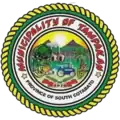 Seal | |
| Motto: Mabulawanong Tampakan | |
 Map of South Cotabato with Tampakan highlighted | |
OpenStreetMap | |
.svg.png) Tampakan Location within the Philippines | |
| Coordinates: 6°27′N 124°56′E / 6.45°N 124.93°E | |
| Country | Philippines |
| Region | Soccsksargen |
| Province | South Cotabato |
| District | 1st district |
| Founded | June 21, 1970 |
| Barangays | 14 (see Barangays) |
| Government | |
| • Type | Sangguniang Bayan |
| • Mayor | Leonard T. Escobillo (ATM-PFP) |
| • Vice Mayor | Anadel T. Magbanua (ATM-PFP) |
| • South Cotabato 1st District Representative | Isidro D. Lumayag (PFP) |
| • Councilors | Michael T. Escobillo (ATM-PFP) John Mark C. Baldon (ATM-PFP) Erve T. Tutor Roy M. Cagas (ATM-PFP) Celso F. Doc (ATM-PFP) Alexey C. Cariaga (ATM-PFP) Anadel T. Magbanua (ATM-PFP) Catherine T. Tabaco (ATM-PFP) Erve T. Tutor (ATM-PFP) Sotero N. Castillanes (ABC Ex Officio) Amay Collado (IPMR Ex Officio) Christian Dave Ho (SK Ex Officio) |
| • Electorate | 30,461 voters (2025) |
| Area | |
• Total | 390.00 km2 (150.58 sq mi) |
| Elevation | 152 m (499 ft) |
| Highest elevation | 1,400 m (4,600 ft) |
| Lowest elevation | 68 m (223 ft) |
| Population (2024 census)[3] | |
• Total | 42,304 |
| • Density | 110/km2 (280/sq mi) |
| • Households | 10,472 |
| Economy | |
| • Income class | 1st Class Municipality |
| • Poverty incidence | 18.25 |
| • Revenue | ₱ 227.6 million (2022) |
| • Assets | ₱ 466.8 million (2022) |
| • Expenditure | ₱ 189.9 million (2022) |
| • Liabilities | ₱ 466.8 million (2022) |
| Service provider | |
| • Electricity | South Cotabato 1 Electric Cooperative (SOCOTECO 1) |
| Time zone | UTC+8 (PST) |
| ZIP code | 9507 |
| PSGC | |
| IDD : area code | +63 (0)83 |
| Native languages | Hiligaynon Cebuano Maguindanao Kalagan Tagalog |
| Website | tampakanscot |
Tampakan, officially the Municipality of Tampakan (Hiligaynon: Banwa sang Tampakan; Cebuano: Lungsod sa Tampakan; Ilocano: Ili ti Tampakan; Tagalog: Bayan ng Tampakan; Maguindanaon: Inged nu Tampakan, Jawi: ايڠد نو تمڤاكن), is a municipality in the province of South Cotabato, Philippines. According to the 2020 census, it has a population of 41,018 people.[5]
History
Tampakan was once a barangay of the Municipality of Tupi, South Cotabato. It was a forested area inhabited by natives called B'laans. At that time, the place was still diverse in terms of flora and fauna. Tampakan was derived from the term "tamfaken", a native word of the B'laan language which means "spring," as the place had plenty of it. Abundant springs were spread at the center of the barrio and flowed out into streams that traversed almost the entire area, serving as the main source of potable water for the inhabitants.
It was in the mid-1940s when the first batch of landless pioneer settlers was brought in from Luzon, Leyte, and Panay in search of greener pastures. These settlers, armed with determination and courage, crossed the ocean to reach this place, which was then unknown to them. The settlers lived in a bunkhouse built from round logs during that time. The building was large enough to accommodate a hundred families and once stood on the same site where the present Petron gas station is now located. They lived in this communal dwelling until home lots were distributed to each settler family, facilitated by the National Land Settlement Administration.
Not long after the families had settled, World War II broke out in December 1940 and lasted for about four years. An Allied landing strip was constructed in Tampakan in 1941. Accounts from settlers revealed that a total of 13 bombs were dropped by U.S. planes on Tampakan. Months later, the Japanese Imperial Forces reached the settlement and confiscated the settlers' animals and carts, which were then used to transport ammunition and other weapons from Koronadal to Tacurong in Sultan Kudarat.
Despite the disturbance of war, development efforts continued. While some settlers returned to their places of origin due to the harsh physical and economic conditions, many others remained determined and chose to stay and establish a life in Tampakan. After the war, more Christian settlers arrived in the area. The native B'laans, feeling outnumbered and inferior, gradually moved to the upland areas of the locality. With the influx of more people, the once-abundant springs eventually dried up. As a result, the tamfaken is no longer visible today.
In 1963, Hon. Emilo B. Escobillo, Sr. won by landslide victory as the Municipal MayorTupi, South Cotabato. As the Municipality Mayor of Tupi, Hon. Emilio B. Escobillo , Sr. initiated the separation of then Barangay Tampakan from its mother municipality of Tupi. Hon. Alfredo C. Cagas was elected Vice Mayor of Tupi. The joint effort of Hon. Emilio B. Escobillo and Hon. Alfredo C. Cagas and then Councilors Fernando Villanueva and Ireneo T. Barroso resulted to the creation of Tampakan into a municipality through Presedential Proclamation of then President Diosdado Macapagal. The first appointed mayor was the late Hon. Anastacio V. Navato, Sr. who served th office for twelve (12) days and then succumbed to death. The late Hon. Ireneo T. Barroso, then councilor of Tupi, South Cotabato succeeded the mayoral post. In 1965 pursuant to Revised Administrative Code, Tampakan was reverted to Barangay and Tampakan’s creation as a Municipality was forwarded for legislation of Congress
When Hon. Emilio B. Escobillo, Sr. was elected Vice Governor of South Cotabato, hepursued the effort of creating Tampakan into a municipality. So that, on June 21, 1969, Republic Act. No. 5661 was passed and approved in the Senate and the House of Representative creating the Municipality of Tampakan. As embodied in Republic Act. No.5661, the municipality was composed of the barrios of Tampakan, Maltana, Liberty, Kipalbig, and the Sitios Buto, Lambayong, Korondatal, Tablu, Liberty II and Miasong, all from the municipality of Tupi
Years passed, and Tampakan gradually developed into an agricultural frontier. The once-forested area became an ideal place to live for the settlers, their families, and even their grandchildren. Through years of dedication and hard work, the settlers were able to build a community that eventually evolved into the municipality now known as Tampakan.
Government Officials
Municipal Officials
Executive Branch
Mayor
| No. | Mayor | Party | Start of term | End of term | |
|---|---|---|---|---|---|
| 10 | Leonard T. Escobillo, RN | ATM-PFP | June 30, 2019 | June 30, 2025 | |
Legislative Branch
Vice-Mayor
| No. | Mayor | Party | Start of term | End of term | |
|---|---|---|---|---|---|
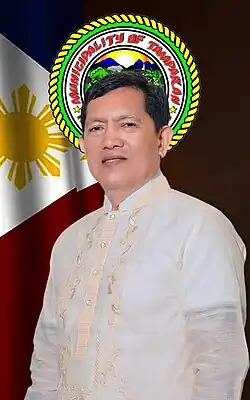
|
Ric "Toton" A. Magbanua | ATM-PFP | June 30, 2025 | June 30, 2028 | |
Councilors
| District/ League/ Sector | Councilor | Party | Start of term | End of term | ||
|---|---|---|---|---|---|---|
| Micheal T. Escobillo | Lone | ATM-PFP | June 30, 2025 | June 30, 2028 | ||
| John Mark "Bobsi" C. Baldon | Lone | ATM-PFP | June 30, 2022 | June 30, 2028 | ||
| Erve T. Tutor | Lone | ATM-PFP | June 30, 2019 | June 30, 2028 | ||
| Roy M. Cagas | Lone | ATM-PFP | June 30, 2019 | June 30, 2028 | ||
| Celso F. Doc | Lone | ATM-PFP | June 30, 2019 | June 30, 2028 | ||
| Alexey "Totoy" C. Cariaga | Lone | ATM-PFP | June 30, 2022 | June 30, 2028 | ||
| Anadel "Dodong" T. Magbanua | Lone | ATM-PFP | June 30, 2025 | June 30, 2028 | ||
| Catherine T. Tabaco | Lone | ATM-PFP | June 30, 2025 | June 30, 2028 | ||

|
Sotero N. Castillanes | ABC | Nonpartisan | July 8, 2025 | December 31, 2025 | |

|
Amay Collado | IPMR | Nonpartisan | December 31, 2025 | ||

|
Christian Dave Ho | SK | Nonpartisan | January 1, 2024 | December 31, 2025 | |
Barangay Officials
Tampakan is politically subdivided into 14 barangays. Each barangay consists of puroks while some have sitios. Brgy. Captain Neil Ryan Escobillo currently serves as the ABC President of Tampakan and concurrently holds the position of ABC President for the Province of South Cotabato. In view of his provincial responsibilities, the ABC Vice President of Tampakan, Brgy. Captain Sotero N. Castillanes, assumes the role of ex officio member representing Tampakan.
There are 3 barangays which classified as urban (highlighted in bold)
| Barangay | Barangay Captain | SK Chairman |
|---|---|---|
| Albagan | Jito V. Suhot | Trixie Megan Carillo |
| Buto | Ferdinand S. Encia | Eddie Luie Amora |
| Danlag | Judith J. Magbanua | Christian Dave Ho (SK President) |
| Kipalbig | Rolando D. Malabuyoc | Jester Cloyd Oñez |
| Lambayong | Glenn F. Tabano | Vincent Paul Bunga |
| Liberty | Nolin S. Jalagat | Jorimar Cabañas |
| Lampitak | Marinillo M. Ngalon | Vanessa Garcia |
| Maltana | Eric Entong | John Rupert Suba |
| Poblacion | Jose Nilo G. Vargas | Ian Clark Cornelio |
| Palo | Sotero N. Castillanes (ABC Vice President) | Angel Grace Panes |
| Pula Bato | Neil Ryan T. Escobillo (ABC President - Tampakan & South Cotabato) | Jhemer John Gulay |
| San Isidro | Armando C. Serida | Sharia Uy |
| Santa Cruz | Wilfredo M. Epe | |
| Tablu | Gloria P. Magbanua | Gretz Paul Obaña |
Former Mayors and Vice Mayors
| No. | Mayor | Tenure | Vice mayor | ||
|---|---|---|---|---|---|
| 1 |  |
Anastacio Navato, Sr. (Appointed) | 1964 (12 Days) | ||
| 2 | 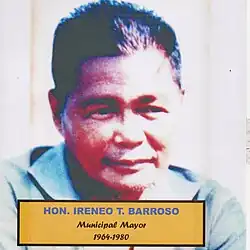
|
Ireneo T. Barroso | 1964 | 1980 | Alfredo C. Cagas |
| 3 | 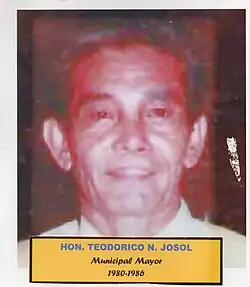
|
Teodorico N. Josol | March 1980 | February 1986 | Rosalina C. Villanueva |
| 4 | 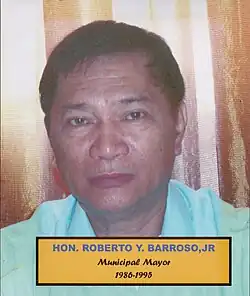
|
Roberto Y. Barroso, Jr. | February 1986 | June 30, 1995 | |
| 5 | 
|
Emilio B. Escobillo, Sr. | June 30, 1995 | June 30, 1998 | Felixberto A. Solaria |
| 6 | 
|
Claudius G. Barroso, CPA | June 30, 1998 | June 30, 2007 | |
| Pedro A. Cagas | |||||
| 7 | Bienvenido G. Barroso, LLB | June 30, 2007 | June 30, 2010 | Pedro A. Cagas | |
| 8 | 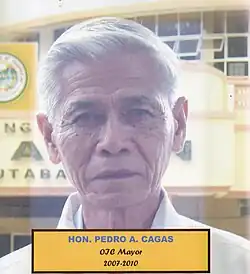
|
Pedro A. Cagas (Acting) | June 30, 2007 | June 30, 2010 | |
| 9 | 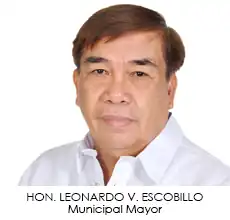
|
Leonardo V. Escobillo, ME | June 30, 2010 | June 30, 2019 | Relly A. Leysa |
| James S. Cagas | |||||
| 10 | 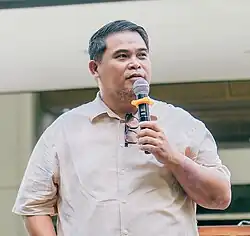
|
Leonard T. Escobillo, RN | June 30, 2019 | June 30, 2028 | John Mark "Bobsi" C. Baldon |
| Anadel "Dodong" T. Magbanua | |||||
| Ric "Toton" A. Magbanua | |||||
Climate
Tampakan, South Cotabato experiences a relatively mild and consistent climate throughout the year. The average daily maximum temperature ranges from 22 °C to 24 °C (72 °F to 75 °F), while the minimum stays between 15 °C and 17 °C (59 °F to 63 °F). Rainfall is spread across the year, with a total annual precipitation of approximately 1,623 mm (63.9 inches). The wettest months are June to October, each receiving over 180 mm of rain and experiencing 25 to 27 rainy days. In contrast, the driest months are January to March, with rainfall below 60 mm and fewer than 12 rainy days per month. Overall, the climate is cool and wet, especially during the mid-year monsoon season.
| Climate data for Tampakan, South Cotabato | |||||||||||||
|---|---|---|---|---|---|---|---|---|---|---|---|---|---|
| Month | Jan | Feb | Mar | Apr | May | Jun | Jul | Aug | Sep | Oct | Nov | Dec | Year |
| Mean daily maximum °C (°F) | 23 (73) |
23 (73) |
24 (75) |
24 (75) |
23 (73) |
22 (72) |
22 (72) |
22 (72) |
22 (72) |
22 (72) |
22 (72) |
23 (73) |
23 (73) |
| Mean daily minimum °C (°F) | 15 (59) |
15 (59) |
15 (59) |
16 (61) |
17 (63) |
17 (63) |
16 (61) |
16 (61) |
16 (61) |
16 (61) |
16 (61) |
16 (61) |
16 (61) |
| Average precipitation mm (inches) | 54 (2.1) |
41 (1.6) |
56 (2.2) |
81 (3.2) |
154 (6.1) |
212 (8.3) |
223 (8.8) |
218 (8.6) |
192 (7.6) |
184 (7.2) |
135 (5.3) |
73 (2.9) |
1,623 (63.9) |
| Average rainy days | 10.4 | 9.1 | 11.2 | 14.4 | 24.6 | 27.0 | 26.7 | 26.1 | 25.6 | 26.9 | 22.6 | 15.1 | 239.7 |
| Source: Meteoblue[6] | |||||||||||||
Demographics
Tampakan, a municipality in South Cotabato, Philippines, has experienced consistent population growth over the decades. According to the Philippine Statistics Authority, the population rose from 10,731 in 1970 to 41,018 in 2020. The most significant growth occurred between 1970 and 1975, with an annual increase of 8.16%. Growth continued at a steadier pace in the following decades, with the population reaching 18,057 in 1980, 25,526 in 1990, and 33,011 in 2000. While growth persisted into the 21st century, it began to slow, recording 34,245 in 2007, 36,254 in 2010, and 39,525 in 2015. By 2020, the growth rate had declined to 0.73% annually. This gradual deceleration suggests a shift toward population stabilization in recent years.
| Year | Pop. | ±% p.a. |
|---|---|---|
| 1970 | 10,731 | — |
| 1975 | 15,867 | +8.16% |
| 1980 | 18,057 | +2.62% |
| 1990 | 25,526 | +3.52% |
| 1995 | 28,256 | +1.92% |
| 2000 | 33,011 | +3.39% |
| 2007 | 34,245 | +0.51% |
| 2010 | 36,254 | +2.10% |
| 2015 | 39,525 | +1.66% |
| 2020 | 41,018 | +0.78% |
| 2024 | 42,304 | +0.74% |
| Source: Philippine Statistics Authority[7][8][9][10][11] | ||
Religion
Churches in Tampakan:
- Lifehouse Community of Faith, Inc. (SBC), Brgy. Poblacion
- Greenland Community Church (SBC), Brgy. Buto
- Greenview Baptist Church (SBC), Brgy. Buto
- Amazing Grace Baptist Church (SBC), Brgy. Maltana
- Snip Baptist Church (SBC), Brgy. Tablu
- Liberty Baptist Church (SBC), Brgy. Liberty
- Seventh-Day Adventist Church, Brgy. Sta. Cruz
- Kingdom Hall of Jehovah's Witnesses, Brgy. Poblacion
- Born Again Sanctuary of Praise, Brgy. Poblacion
- Iglesia Ni Cristo, Brgy. Poblacion
- Assembly of God Church, Brgy. Poblacion
Economy
Poverty incidence of Tampakan
10
20
30
40
50
2000
49.12 2003
27.52 2006
31.40 2009
33.05 2012
37.26 2015
36.55 2018
30.90 2021
18.25 Source: Philippine Statistics Authority[12][13][14][15][16][17][18][19] |
There is a proposed copper and gold mine in Tampakan. Once approved for operations, the Tampakan Copper-Gold Project will be the largest in the Philippines and among the largest copper mines in the world.[20]
The local government of Tampakan has for now cancelled its agreement with Sagittarius Mines to develop the reserves into a mine in 2020 alleging that the terms of the deal is lopsided against residents and the community[21]
References
- ^ Municipality of Tampakan | (DILG)
- ^ "2015 Census of Population, Report No. 3 – Population, Land Area, and Population Density" (PDF). Philippine Statistics Authority. Quezon City, Philippines. August 2016. ISSN 0117-1453. Archived (PDF) from the original on May 25, 2021. Retrieved July 16, 2021.
- ^ "2024 Census of Population (POPCEN) Population Counts Declared Official by the President". Philippine Statistics Authority. 17 July 2025. Retrieved 18 July 2025.
- ^ "PSA Releases the 2021 City and Municipal Level Poverty Estimates". Philippine Statistics Authority. 2 April 2024. Retrieved 28 April 2024.
- ^ "2024 Census of Population (POPCEN) Population Counts Declared Official by the President". Philippine Statistics Authority. 17 July 2025. Retrieved 18 July 2025.
- ^ "Tampakan: Average Temperatures and Rainfall". Meteoblue. Retrieved 15 May 2020.
- ^ "2024 Census of Population (POPCEN) Population Counts Declared Official by the President". Philippine Statistics Authority. 17 July 2025. Retrieved 18 July 2025.
- ^ Census of Population (2015). "Region XII (Soccsksargen)". Total Population by Province, City, Municipality and Barangay. Philippine Statistics Authority. Retrieved 20 June 2016.
- ^ Census of Population and Housing (2010). "Region XII (Soccsksargen)" (PDF). Total Population by Province, City, Municipality and Barangay. National Statistics Office. Retrieved 29 June 2016.
- ^ Censuses of Population (1903–2007). "Region XII (Soccsksargen)". Table 1. Population Enumerated in Various Censuses by Province/Highly Urbanized City: 1903 to 2007. National Statistics Office.
- ^ "Province of". Municipality Population Data. Local Water Utilities Administration Research Division. Retrieved 17 December 2016.
- ^ "Poverty incidence (PI):". Philippine Statistics Authority. Retrieved December 28, 2020.
- ^ "Estimation of Local Poverty in the Philippines" (PDF). Philippine Statistics Authority. 29 November 2005.
- ^ "2003 City and Municipal Level Poverty Estimates" (PDF). Philippine Statistics Authority. 23 March 2009.
- ^ "City and Municipal Level Poverty Estimates; 2006 and 2009" (PDF). Philippine Statistics Authority. 3 August 2012.
- ^ "2012 Municipal and City Level Poverty Estimates" (PDF). Philippine Statistics Authority. 31 May 2016.
- ^ "Municipal and City Level Small Area Poverty Estimates; 2009, 2012 and 2015". Philippine Statistics Authority. 10 July 2019.
- ^ "PSA Releases the 2018 Municipal and City Level Poverty Estimates". Philippine Statistics Authority. 15 December 2021. Retrieved 22 January 2022.
- ^ "PSA Releases the 2021 City and Municipal Level Poverty Estimates". Philippine Statistics Authority. 2 April 2024. Retrieved 28 April 2024.
- ^ "The Tampakan Copper-Gold Project ( TCGP )". 20 March 2021.
- ^ Sarmiento, Bong (30 August 2020). "Officials quash plan, for now, to develop Philippines' biggest copper mine". Mongabay.